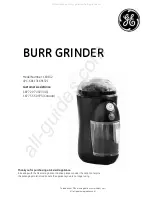
9
Caring for your Espresso Maker
10. Remove the
portafilter handle
from the
brew head (21).
11. Discard the used
coffee grinds or pod/
pods from the filter
basket (22). Place the
porta-filter holder into
slide lock position
when discarding
grinds so basket
stays in place.
Sleep Mode
After 30 minutes of non-use
the espresso machine will automatically switch
to sleep mode. An indication that the machine is
in sleep mode is that the power light will slowly
flash. After a further 1½ hours of non-use, the
espresso machine will turn off.
GUIDE TO MILK
TEXTURING
Milk texturing is the steaming of milk. The steam
does two things; it heats the milk and mixes air
with the milk to form a foamy texture. As with
learning to make an espresso, perfecting the art
of milk texturing takes time and practice.
1. Determine how much milk is needed based
on the number of cups being made.
TIP:
Keep in mind that the volume of milk will
increase during the texturing.
2. Pour cold refrigerated milk into the stainless
frothing pitcher, approximately ½ full.
3. Press the steam button which will flash, and
become solid when unit is ready for use.
4. Purge the steam wand of any water. With
the steam wand positioned over the drip
tray, activate the steam function by turning
the steam and hot water control dial to the
left (23). Once any water has been purged
stop the steam by turning the steam and hot
water control dial to the
O
position (24).
5. Swing the steam wand to the side of the
espresso machine (25).
6. Place the steam wand into the milk so that
the nozzle is about a half-inch below the
surface and activate the steam function by
turning the steam
and hot water control
dial to left (26).
7. Angle the pitcher so that the steam wand is
resting on the spout of the pitcher and lower
the pitcher until the tip of the steam nozzle is
just below the surface of the milk. This will
start to create a whirlpool action in the milk
(27).
NOTE:
Do not allow the steam to spurt unevenly
or it will create aerated froth/large bubbles. If
this is happening, raise the pitcher so that the
steam nozzle is lowered farther into the milk.
8. As the steam heats and textures the milk,
the level of the milk in the pitcher will begin
to rise. As this happens, follow the level of
the milk by lowering the pitcher, always
keeping the tip of the steam nozzle just
below the surface.
9. Once the foam is created, raise the pitcher
until the steam nozzle is in the center of the
milk.
21
22
23
24
25
26
27







































